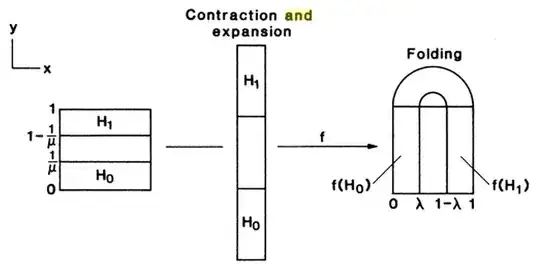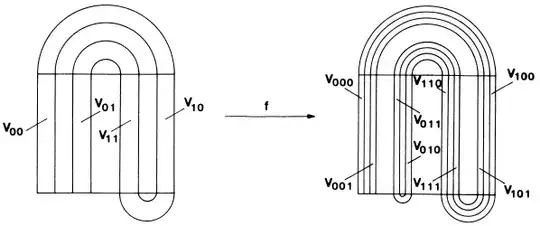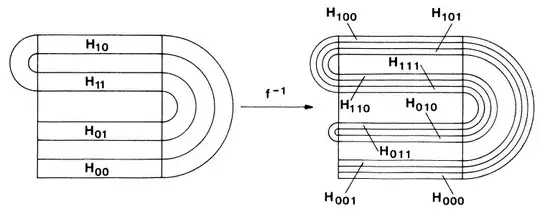At the moment I'm doing a project about the Smale horseshoe map. This is a function which maps a square $D= \{(x,y)\in \mathbb{R}^2: 0\le x\le 1,\text{ } 0\le y \le 1 \} $ to a 'horseshoe'. It contracts in the $x$-direction, expands the $y$-direction and folds around, like in the picture:

The goal of the text is to study the invariant set under $f$: we are interested in the points which will stay forever in $D$ if you apply $f$ or $f^{-1}$ arbitrary often. That is, we want to look at the set $...\cap f^{-1}\cap D\cap f(D)\cap f^2(D)\cap ...$
Therefore, it's only necessary to define the function for $H_0$ and $H_1$, because the other elements are being mapped outside $D$, so we can just ignore those. $H_0, H_1$ can be described as:
\begin{equation} H_0= \{(x,y)\in \mathbb{R}^2: 0\le x\le 1, \text{ } 0\le y \le 1/{\mu} \} \end{equation}
\begin{equation} H_1= \{(x,y)\in \mathbb{R}^2: 0\le x\le 1, \text{ } 1-1/{\mu} \le y \le 1 \} \end{equation}
Then, the definition of those subsets is as follows:
\begin{equation} H_0: \begin{pmatrix} x \\y \end{pmatrix} \mapsto \begin{pmatrix} \lambda & 0 \\ 0 & \mu \end{pmatrix} \begin{pmatrix} x \\y \end{pmatrix} \end{equation}
\begin{equation} H_1: \begin{pmatrix} x \\y \end{pmatrix} \mapsto \begin{pmatrix} -\lambda & 0 \\ 0 & -\mu \end{pmatrix} \begin{pmatrix} x \\y \end{pmatrix} + \begin{pmatrix} 1 \\\mu \end{pmatrix} \end{equation}
If we keep applying $f$ on the domain, the set $D\cap f(D) \cap f^2(D) \cap ...$ will develop as follows:

While if we keep applying $f^{-1}$ we get the following result:

As you can see, if we take the intersection of both, and letting the number of iterations go to infinity, we get intersections of horizontal and vertical rectangles, which are just points.
So, now my question is: What's the point of this? What are the theoretically interesting aspects of this map? What applications are there for this map?